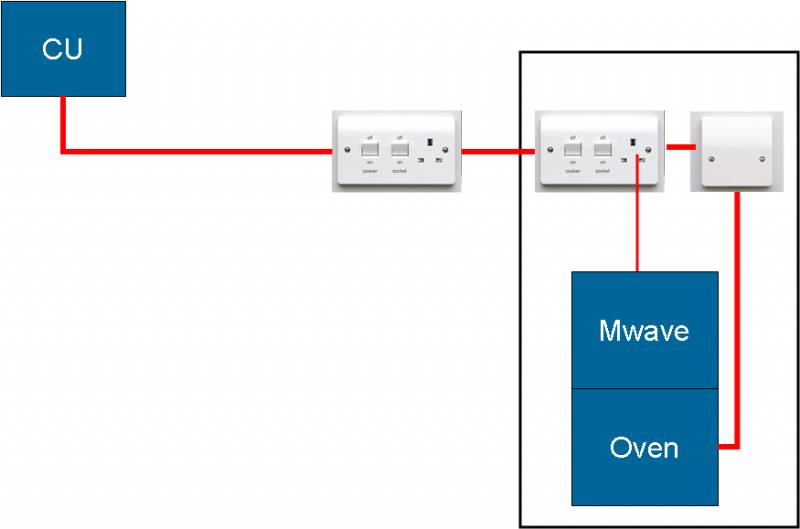Hi
I want to swap a built-in double oven for a separate single oven (3.6KW) and combination microwave (3KW) both of which will be built into to same space and connected to my 30AMP cooker circuit.
The existing wiring is a 30AMP MCB radial circuit to 45AMP cooker switch/socket (MK) with buried 10mm T&E to back of oven housing.
Complexity arises due to new microwave requiring a 13 amp socket whereas single oven requires 6mm T&E connection. I have no easy way of getting a ring main spur to the back of the microwave.
Question:
Is it ok to add a second MK oven switch/socket (K5040WHI) behind the built-in cabinet to feed both devices from the existing 45 AMP switch?
All cable will be 10mm T&E (apart from the flex to the microwave) and I'll end up with two cooker switches in series with the load on the accessible one feeding the hidden second one into which both devices are connected?
The hidden one will always be left on - cooker and socket.
Creating a new spur off the kitchen ring with isloating switch for the microwave combination oven is difficult as it will require removing tiling.
I also don't like the idea of a normal 13AMP socket spur with 10mm cable.
I understand this is ok with regs provided all cable is same size.
Max load on the new circuit would be 16 AMP (single oven) + 12.5 (microwave) + 13 AMP for visible socket = 42 AMPs.
I'd probably use a K5045WHI for the 10mm buried cable outlet.
Is this ok or am I being stupid? Should I get an electrican to upgrade the MCB or leave it at 30AMP?
Thanks for your advice
I want to swap a built-in double oven for a separate single oven (3.6KW) and combination microwave (3KW) both of which will be built into to same space and connected to my 30AMP cooker circuit.
The existing wiring is a 30AMP MCB radial circuit to 45AMP cooker switch/socket (MK) with buried 10mm T&E to back of oven housing.
Complexity arises due to new microwave requiring a 13 amp socket whereas single oven requires 6mm T&E connection. I have no easy way of getting a ring main spur to the back of the microwave.
Question:
Is it ok to add a second MK oven switch/socket (K5040WHI) behind the built-in cabinet to feed both devices from the existing 45 AMP switch?
All cable will be 10mm T&E (apart from the flex to the microwave) and I'll end up with two cooker switches in series with the load on the accessible one feeding the hidden second one into which both devices are connected?
The hidden one will always be left on - cooker and socket.
Creating a new spur off the kitchen ring with isloating switch for the microwave combination oven is difficult as it will require removing tiling.
I also don't like the idea of a normal 13AMP socket spur with 10mm cable.
I understand this is ok with regs provided all cable is same size.
Max load on the new circuit would be 16 AMP (single oven) + 12.5 (microwave) + 13 AMP for visible socket = 42 AMPs.
I'd probably use a K5045WHI for the 10mm buried cable outlet.
Is this ok or am I being stupid? Should I get an electrican to upgrade the MCB or leave it at 30AMP?
Thanks for your advice


